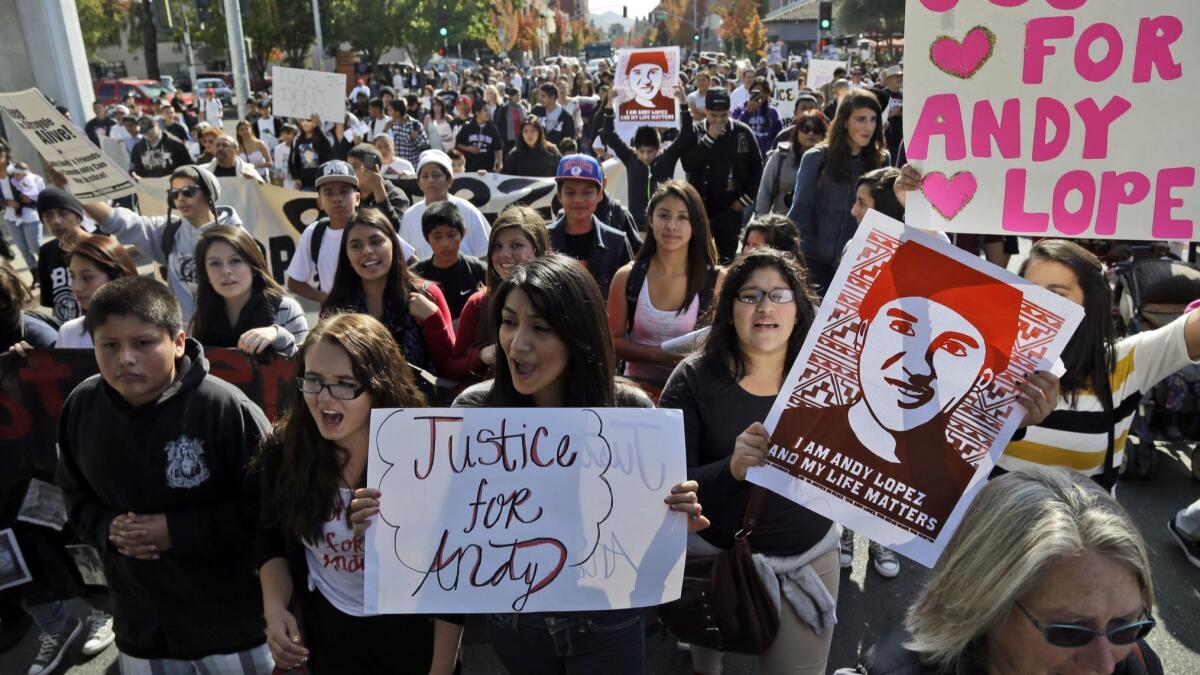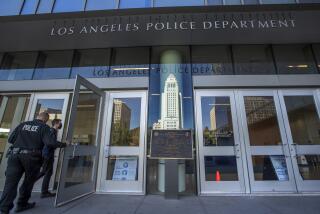Supreme Court asked to shield Sonoma County deputy who killed a 13-year-old carrying a pellet gun

- Share via
Reporting from Washington — It was an October afternoon when 13-year-old Andy Lopez, wearing shorts and a blue sweatshirt, walked down a sidewalk in Santa Rosa, Calif., loosely carrying at his side a plastic pellet gun that resembled an assault rifle.
Two Sonoma County sheriff’s deputies were driving in the neighborhood on a routine patrol. When Officer Erick Gelhaus, an Iraq war veteran, spotted the 5-foot-3 teenager, he thought the boy might be carrying an AK-47.
Their patrol car swung behind Andy. From 60 feet away, Gelhaus jumped out, crouched behind the door and shouted “Drop the gun!”
As Andy began to turn toward him, Gelhaus fired eight shots, killing the boy.
This week, the U.S. Supreme Court is being asked to shield the deputy from being sued by the parents of the boy on the grounds that no law “squarely governs” this situation and would have alerted the officer that shooting the teenager on the sidewalk amounted to the use of “excessive force.”
Decision time: Supreme Court tackles cases on gay rights, gerrymandering, unions »
Joined by several California law enforcement groups, Sonoma County’s lawyers are urging the justices to “support the common sense proposition that officers need not wait for a gun to actually be leveled or pointed at them before responding with deadly force to protect themselves and the public.”
They stand a good chance of prevailing, even though the high court grants only about 1% of appeal petitions.
In recent years, the justices have regularly intervened in police shooting cases to overturn rulings that cleared the way for a jury to decide whether an officer used excessive force.
In April, the high court, by a 7-2 vote, tossed out a lawsuit against a Tucson police officer who shot a woman four times as she stood in her front yard holding a large kitchen knife. The officer, one of three who came on the scene, decided she was threatening another woman who stood six feet away. The other woman later testified they were housemates, and she did not feel threatened.
The justices reversed the U.S. 9th Circuit Court of Appeals, which had allowed the woman’s suit to proceed. “Use of excessive force is an area of law in which the result depends very much on the facts of each case, and thus police officers are entitled to qualified immunity unless existing precedent squarely governs the specific facts at issue,” the court said in Kisela vs. Hughes.
In dissent, Justices Sonia Sotomayor and Ruth Bader Ginsburg said the decision “sends an alarming signal to law enforcement officers … that they can shoot first and think later.”
The shooting of Andy Lopez in 2013 sparked protests in Santa Rosa and an FBI investigation. But no charges were brought against Gelhaus, and the officer returned to duty in two months.
Andy’s parents sued under the long-standing federal civil rights law that authorizes suits against officers who violate a person’s constitutional rights. In this instance, the suit alleged a violation of the 4th Amendment’s ban on “unreasonable searches and seizures.”
Chief District Judge Phyllis Hamilton in Oakland refused to grant immunity to the officer, and the 9th Circuit Court, by a 2-1 vote, affirmed her decision last year.
Judge Milan D. Smith, an appointee of President George W. Bush, said the officer did not appear to face an imminent threat.
“Andy was walking normally … in broad daylight in a residential neighborhood” and carrying a weapon that another driver in the area saw as being a toy gun, even though it did not have an orange plastic tip. “Gelhaus deployed deadly force while Andy was standing on the sidewalk holding a gun that was pointed down at the ground,” Smith wrote. And he “shot without having warned [him] that such force would be used, and without observing any aggressive behavior.”
In dissent, Judge Clifford Wallace, a Nixon appointee, called the case “tragic. A boy lost his life, needlessly, as it turns out.” But the suit should be dismissed nonetheless. “The majority greatly understates the potential danger Andy posed as perceived by Deputy Gelhaus. [He] reasonably believed that Andy was carrying an AK-47,” he wrote.
Sonoma County appealed to the Supreme Court in Gelhaus vs. Lopez and said the recent ruling in the Tucson case calls for throwing out the suit against the deputy.
“No existing precedent ‘squarely governs’ the ‘specific facts’ at issue here,” the county said. Its petition described “the specific situation” as “an individual apparently armed with an assault rifle refusing to drop a weapon. … An officer need not wait to be put in harm’s way before responding in defense of himself and the surrounding community … when confronting an assault weapon capable of spraying 30 bullets in seconds.”
The justices considered the appeal in their private conference on May 31 and relisted it for further consideration this past week. They could act on the case as soon as Monday.
If they deny the appeal, the parents’ suit would go to trial in Oakland. The court could agree to hear the case in the fall. Or the justices may reverse the 9th Circuit’s decision to allow the suit by citing their recent ruling in the Tucson case.
More stories from David G. Savage »
Twitter: DavidGSavage
More to Read
Get the L.A. Times Politics newsletter
Deeply reported insights into legislation, politics and policy from Sacramento, Washington and beyond. In your inbox twice per week.
You may occasionally receive promotional content from the Los Angeles Times.











